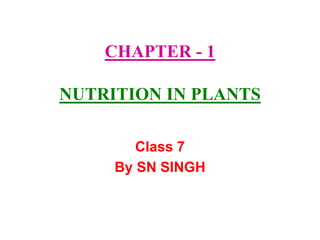
Science.ppt
- 1. CHAPTER - 1 NUTRITION IN PLANTS Class 7 By SN SINGH
- 2. 1) Nutrients :- The components of food like carbohydrates, fats, proteins vitamins and minerals are called nutrients. Nutrients help living organisms :- i) To build their bodies. ii) To grow. iii) To repair the damaged parts of their bodies. iv) To provide energy to carry out life processes.
- 3. 2) Nutrition :- The mode of taking food by an organism and its utilization in the body is called nutrition. 3) Modes of nutrition :- There are two main modes of nutrition in living organisms. They are autotrophic nutrition and heterotrophic nutrition. i) Autotrophic nutrition :- is nutrition in which organisms can prepare their own food. Organisms which can prepare their own food are called autotrophs. ii) Heterotrophic nutrition :- is nutrition in which organisms get their food directly or indirectly from plants. Organisms which get their food directly or indirectly from plants are called heterotrophs.
- 4. 4)Photosynthesis - Food making process in plants :- Photosynthesis is the process by which plants prepare their on food by using sunlight, water, carbon dioxide and chlorophyll. Photosynthesis take place in the leaves. i) Sunlight is obtained from the sun. ii) Water is absorbed by the roots and transported to the leaves. iii) Carbon dioxide is taken from the air through small pores in the leaves called stomata. iv) Chlorophyll are the green pigments present in the leaves.
- 6. Chlorophyll uses the energy from sunlight to prepare food by using water and carbon dioxide. The food prepared is carbohydrate which is then converted into starch. During photosynthesis oxygen is released. Equation of photosynthesis :- Sunlight Carbon dioxide + Water Carbohydrate + Oxygen Chlorophyll
- 7. 5) Synthesis of proteins :- The soil has some bacteria which convert nitrogen from the air into usable nitrogen in the soil. Farmers also add fertilisers containig nitrogen into the soil. Plants absorb this nitrogen from the soil along with water and other constituents to prepare proteins and fats.
- 8. 6) Other modes of nutrition in plants :- i) Parasitic plants :- are plants which do not have chlorophyll and cannot prepare their own food. They get their food from other plants called host . Eg :- Cuscuta ( Amarbel)
- 9. • ii) Insectivorous plants :- are plants which feed on insects. Eg:- Pitcher plant. The leaf of the pitcher plant is modified into a pitcher. The end of the pitcher has a lid which can open and close. When an insect enters the pitcher, the lid closes. The insect is then digested by digestive juices inside the pitcher.
- 10. • iii) Saprotrophs :- are plants which do not have chlorophyll and cannot prepare their on food. They get their food from dead and decaying organic matter. Eg :- mushroom, bread mould etc. They produce digestive juice on the dead and decaying organic matter and convert it into a solution and then absorb the nutrients from the solution.
- 11. iv) Symbiotic relationship :- Some plants live together and share shelter and nutrients. Eg :- lichens. In lichens, an alga and a fungus live together. The fungus provides shelter, water and minerals to the alga. The alga provides food to the fungus which it prepares by photosynthesis.
- 12. 7) How nutrients are replenished in the soil :- Plants absorb nutrients from the soil. So the nutrients in the soil decreases. So farmers add manures and fertilisers to the soil to increase the nutrients in the soil. The bacterium called rhizobium which lives in the roots of leguminous plants like grams, peas, beans etc. converts nitrogen from the air into soluble form in the soil and makes the soil rich in nitrogen. In return the plant provides food and shelter to the bacteria. So they have a symbiotic relationship.
- 13. Activity – 1 :- To show that sunlight is necessary for photosynthesis :- Take two potted plants of the same kind. Keep one in sunlight and the other in a dark room for 2 – 3 days. Then take a leaf from both the plants and test for starch. Put the leaves in a test tube. Pour some spirit in it and put the test tube in a beaker containing water. Boil the water till all the green colour in the leaves comes out into the spirit. Then take the leaves and wash it in water. Put the leaves on a dish and pour some iodine solution over it. The leaf of the plant kept in sunlight turns blue black. The leaf of the plant kept in the dark does not turn blue black. This shows that sunlight is necessary for photosynthesis.
- 14. Activity – 2 :- To observe the fungus bread mould in in bread :- Take a piece of bread and moisten it with water. Leave it in a warm place for 2 – 3 days till fluffy patches appear on them. Observe the patches under a magnifying glass or microscope. Cotton like threads are seen on the bread. The cotton like threads are the fungus bread mould. Bread mould is a saprotroph. Saprotrophs get their food from dead and decaying organic matter